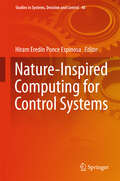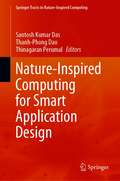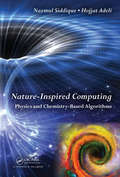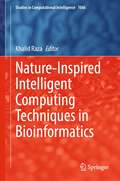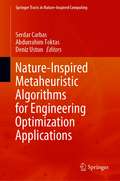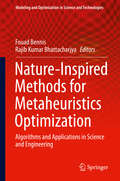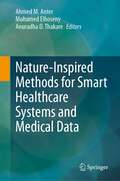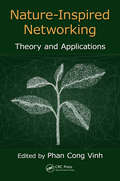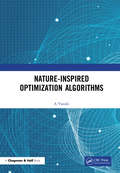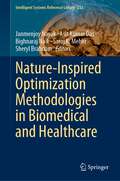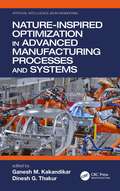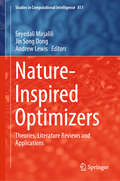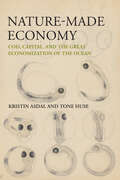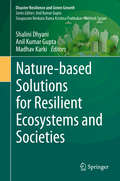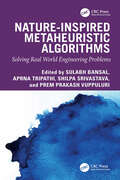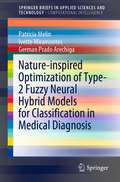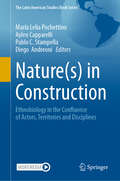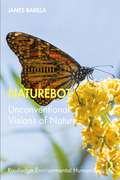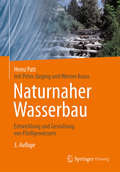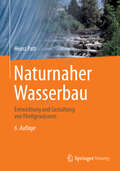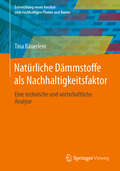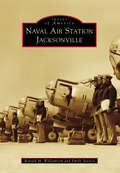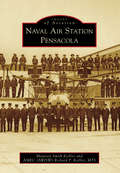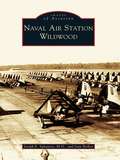- Table View
- List View
Nature-Inspired Computing for Control Systems
by Hiram Eredín Ponce EspinosaThe book presents recent advances in nature-inspired computing, giving a special emphasis to control systems applications. It reviews different techniques used for simulating physical, chemical, biological or social phenomena at the purpose of designing robust, predictive and adaptive control strategies. The book is a collection of several contributions, covering either more general approaches in control systems, or methodologies for control tuning and adaptive controllers, as well as exciting applications of nature-inspired techniques in robotics. On one side, the book is expected to motivate readers with a background in conventional control systems to try out these powerful techniques inspired by nature. On the other side, the book provides advanced readers with a deeper understanding of the field and a broad spectrum of different methods and techniques. All in all, the book is an outstanding, practice-oriented reference guide to nature-inspired computing addressing graduate students, researchers and practitioners in the field of control engineering.
Nature-Inspired Computing for Smart Application Design (Springer Tracts in Nature-Inspired Computing)
by Santosh Kumar Das Thinagaran Perumal Thanh-Phong DaoThis book focuses primarily on the nature-inspired approach for designing smart applications. It includes several implementation paradigms such as design and path planning of wireless network, security mechanism and implementation for dynamic as well as static nodes, learning method of cloud computing, data exploration and management, data analysis and optimization, decision taking in conflicting environment, etc. The book fundamentally highlights the recent research advancements in the field of engineering and science.
Nature-Inspired Computing: Physics and Chemistry-Based Algorithms
by Hojjat Adeli Nazmul H. SiddiqueNature-Inspired Computing: Physics and Chemistry-Based Algorithms provides a comprehensive introduction to the methodologies and algorithms in nature-inspired computing, with an emphasis on applications to real-life engineering problems. The research interest for Nature-inspired Computing has grown considerably exploring different phenomena observed in nature and basic principles of physics, chemistry, and biology. The discipline has reached a mature stage and the field has been well-established. This endeavour is another attempt at investigation into various computational schemes inspired from nature, which are presented in this book with the development of a suitable framework and industrial applications. Designed for senior undergraduates, postgraduates, research students, and professionals, the book is written at a comprehensible level for students who have some basic knowledge of calculus and differential equations, and some exposure to optimization theory. Due to the focus on search and optimization, the book is also appropriate for electrical, control, civil, industrial and manufacturing engineering, business, and economics students, as well as those in computer and information sciences. With the mathematical and programming references and applications in each chapter, the book is self-contained, and can also serve as a reference for researchers and scientists in the fields of system science, natural computing, and optimization.
Nature-Inspired Intelligent Computing Techniques in Bioinformatics (Studies in Computational Intelligence #1066)
by Khalid RazaThis book encapsulates and occupies recent advances and state-of-the-art applications of nature-inspired computing (NIC) techniques in the field of bioinformatics and computational biology, which would aid medical sciences in various clinical applications. This edited volume covers fundamental applications, scope, and future perspectives of NIC techniques in bioinformatics including genomic profiling, gene expression data classification, DNA computation, systems and network biology, solving personalized therapy complications, antimicrobial resistance in bacterial pathogens, and computer-aided drug design, discovery, and therapeutics. It also covers the role of NIC techniques in various diseases and disorders, including cancer detection and diagnosis, breast cancer, lung disorder detection, disease biomarkers, and potential therapeutics identifications.
Nature-Inspired Metaheuristic Algorithms for Engineering Optimization Applications (Springer Tracts in Nature-Inspired Computing)
by Serdar Carbas Abdurrahim Toktas Deniz UstunThis book engages in an ongoing topic, such as the implementation of nature-inspired metaheuristic algorithms, with a main concentration on optimization problems in different fields of engineering optimization applications. The chapters of the book provide concise overviews of various nature-inspired metaheuristic algorithms, defining their profits in obtaining the optimal solutions of tiresome engineering design problems that cannot be efficiently resolved via conventional mathematical-based techniques. Thus, the chapters report on advanced studies on the applications of not only the traditional, but also the contemporary certain nature-inspired metaheuristic algorithms to specific engineering optimization problems with single and multi-objectives. Harmony search, artificial bee colony, teaching learning-based optimization, electrostatic discharge, grasshopper, backtracking search, and interactive search are just some of the methods exhibited and consulted step by step in application contexts. The book is a perfect guide for graduate students, researchers, academicians, and professionals willing to use metaheuristic algorithms in engineering optimization applications.
Nature-Inspired Methods for Metaheuristics Optimization: Algorithms and Applications in Science and Engineering (Modeling and Optimization in Science and Technologies #16)
by Fouad Bennis Rajib Kumar BhattacharjyaThis book gathers together a set of chapters covering recent development in optimization methods that are inspired by nature. The first group of chapters describes in detail different meta-heuristic algorithms, and shows their applicability using some test or real-world problems. The second part of the book is especially focused on advanced applications and case studies. They span different engineering fields, including mechanical, electrical and civil engineering, and earth/environmental science, and covers topics such as robotics, water management, process optimization, among others. The book covers both basic concepts and advanced issues, offering a timely introduction to nature-inspired optimization method for newcomers and students, and a source of inspiration as well as important practical insights to engineers and researchers.
Nature-Inspired Methods for Smart Healthcare Systems and Medical Data
by Mohamed Elhoseny Ahmed M. Anter Anuradha D. ThakareThis book aims to gather high-quality research papers on developing theories, frameworks, architectures, and algorithms for solving complex challenges in smart healthcare applications for real industry use. It explores the recent theoretical and practical applications of metaheuristics and optimization in various smart healthcare contexts. The book also discusses the capability of optimization techniques to obtain optimal parameters in ML and DL technologies. It provides an open platform for academics and engineers to share their unique ideas and investigate the potential convergence of existing systems and advanced metaheuristic algorithms. The book's outcome will enable decision-makers and practitioners to select suitable optimization approaches for scheduling patients in crowded environments with minimized human errors.The healthcare system aims to improve the lives of disabled, elderly, sick individuals, and children. IoT-based systems simplify decision-making and task automation, offering an automated foundation. Nature-inspired metaheuristics and mining algorithms are crucial for healthcare applications, reducing costs, increasing efficiency, enabling accurate data analysis, and enhancing patient care. Metaheuristics improve algorithm performance and address challenges in data mining and ML, making them essential in healthcare research. Real-time IoT-based healthcare systems can be modeled using an IoT-based metaheuristic approach to generate optimal solutions.Metaheuristics are powerful technologies for optimization problems in healthcare systems. They balance exact methods, which guarantee optimal solutions but require significant computational resources, with fast but low-quality greedy methods. Metaheuristic algorithms find better solutions while minimizing computational time. The scientific community is increasingly interested in metaheuristics, incorporating techniques from AI, operations research, and soft computing. New metaheuristics offer efficient ways to address optimization problems and tackle unsolved challenges. They can be parameterized to control performance and adjust the trade-off between solution quality and resource utilization. Metaheuristics manage the trade-off between performance and solution quality, making them highly applicable to real-time applications with pragmatic objectives.
Nature-Inspired Networking: Theory and Applications
by Phan Cong-Vinh"Nature-inspired" includes, roughly speaking, "bio-inspired"+"physical-inspired"+"social-inspired"+ and so on. This book contains highly original contributions about how nature is going to shape networking systems of the future. Hence, it focuses on rigorous approaches and cutting-edge solutions, which encompass three classes of major methods: 1) Those that take inspiration from nature for the development of novel problem solving techniques; 2) Those that are based on the use of networks to synthesize natural phenomena; and 3) Those that employ natural materials to compute or communicate.
Nature-Inspired Optimization Algorithms
by Vasuki ANature-Inspired Optimization Algorithms, a comprehensive work on the most popular optimization algorithms based on nature, starts with an overview of optimization going from the classical to the latest swarm intelligence algorithm. Nature has a rich abundance of flora and fauna that inspired the development of optimization techniques, providing us with simple solutions to complex problems in an effective and adaptive manner. The study of the intelligent survival strategies of animals, birds, and insects in a hostile and ever-changing environment has led to the development of techniques emulating their behavior. This book is a lucid description of fifteen important existing optimization algorithms based on swarm intelligence and superior in performance. It is a valuable resource for engineers, researchers, faculty, and students who are devising optimum solutions to any type of problem ranging from computer science to economics and covering diverse areas that require maximizing output and minimizing resources. This is the crux of all optimization algorithms. Features: Detailed description of the algorithms along with pseudocode and flowchart Easy translation to program code that is also readily available in Mathworks website for some of the algorithms Simple examples demonstrating the optimization strategies are provided to enhance understanding Standard applications and benchmark datasets for testing and validating the algorithms are included This book is a reference for undergraduate and post-graduate students. It will be useful to faculty members teaching optimization. It is also a comprehensive guide for researchers who are looking for optimizing resources in attaining the best solution to a problem. The nature-inspired optimization algorithms are unconventional, and this makes them more efficient than their traditional counterparts.
Nature-Inspired Optimization Methodologies in Biomedical and Healthcare (Intelligent Systems Reference Library #233)
by Sheryl Brahnam Janmenjoy Nayak Bighnaraj Naik Asit Kumar Das Saroj K. MeherThis book introduces a variety of well-proven and newly developed nature-inspired optimization algorithms solving a wide range of real-life biomedical and healthcare problems. Few solo and hybrid approaches are demonstrated in a lucid manner for the effective integration and finding solution for a large-scale complex healthcare problem. In the present bigdata-based computing scenario, nature-inspired optimization techniques present adaptive mechanisms that permit the understanding of complex data and altering environments. This book is a voluminous collection for the confront faced by the healthcare institutions and hospitals for practical analysis, storage, and data analysis. It explores the distinct nature-inspired optimization-based approaches that are able to handle more accurate outcomes for the current biomedical and healthcare problems. In addition to providing a state-of-the-art and advanced intelligent methods, it also enlightens an insight for solving diversified healthcare problems such as cancer and diabetes.
Nature-Inspired Optimization in Advanced Manufacturing Processes and Systems (Artificial Intelligence (AI) in Engineering)
by Ganesh M. Kakandikar Dinesh G. ThakurThe manufacturing system is going through substantial changes and developments in light of Industry 4.0. Newer manufacturing technologies are being developed and applied. There is a need to optimize these techniques when applied in different circumstances with respect to materials, tools, product configurations, and process parameters. This book covers computational intelligence applied to manufacturing. It discusses nature-inspired optimization of processes and their design and development in manufacturing systems. It explores all manufacturing processes, at both macro and micro levels, and offers manufacturing philosophies. Nonconventional manufacturing, real industry problems and case studies, research on generative processes, and relevance of all this to Industry 4.0 is also included. Researchers, students, academicians, and industry professionals will find this reference title very useful.
Nature-Inspired Optimizers: Theories, Literature Reviews and Applications (Studies in Computational Intelligence #811)
by Andrew Lewis Jin Song Dong Seyedali MirjaliliThis book covers the conventional and most recent theories and applications in the area of evolutionary algorithms, swarm intelligence, and meta-heuristics. Each chapter offers a comprehensive description of a specific algorithm, from the mathematical model to its practical application. Different kind of optimization problems are solved in this book, including those related to path planning, image processing, hand gesture detection, among others. All in all, the book offers a tutorial on how to design, adapt, and evaluate evolutionary algorithms. Source codes for most of the proposed techniques have been included as supplementary materials on a dedicated webpage.
Nature-Made Economy: Cod, Capital, and the Great Economization of the Ocean
by Kristin Asdal Tone HuseAn exploration of the economization of the ocean through the small modifications that enable great transformations of nature.The ocean is the site of an ongoing transformation that is aimed at creating new economic opportunities and prosperity. In Nature-Made Economy, Kristin Asdal and Tone Huse explore how the ocean has been harnessed to become a space of capital investment and innovation, and how living nature is wrested into the economy even as nature, in turn, resists, adapts to, or changes the economy. The authors&’ innovative methodological and conceptual approaches examine the economy by focusing on surprising and numerous &“little tools&”—such as maps and policy documents, quality patrols, and dietary requirements for the enhancement of species&’ biological propensities—that value, direct, reorder, accomplish, and sometimes fail to serve our ends, but also add up to great change.Throughout Nature-Made Economy, Asdal and Huse follow one species, the Atlantic cod, and explore how it is subjected to different versions of economization. Taking this species as a point of departure, they then provide novel analyses of the innovation economy, the architecture of markets, the settling of prices, and more, revealing how the ocean is rendered a space of intense economic exploitation. Through their analysis, the authors develop a distinct theoretical approach and conceptual vocabulary for studying nature–economy relations.Nature-Made Economy is a significant contribution to the broad field of STS and social studies of markets, as well as to studies of the Anthropocene, the environment, and human–animal relations.
Nature-based Solutions for Circular Management of Urban Water (Circular Economy and Sustainability)
by Alexandros Stefanakis Hasan Volkan Oral Cristina Calheiros Pedro CarvalhoDespite the strong economic growth of the last decades, our modern global society is facing the existential threat of climate change. It is now realized that the linear economic model is not sustainable in the long run and cannot sustain the life standards. The new circular economy approach that is already under discussion suggests the adjustment of our priorities and the re-orientation of the future infrastructure investments. In this context, we are looking for new, innovative and sustainable solutions to increase the resiliency of our societies, to protect and restore the ecosystems, and to maintain the necessary economic growth without further undermining the planet’s boundaries. The well-being of coming generations will depend on our ability to adapt our economies to this challenge. In particular, transforming today’s cities into sustainable cities is one of the main adaptations that will be necessary. A holistic approach looking at cities from a system’s perspective is neededto achieve this goal. Nature-based solutions (NbS) serve exactly this ambitious and multi-factorial purpose due to their inherent ability not only to tackle climate change but also to provide a series of ecosystem services and social benefits. In the urban context, NbS can deal with main challenges such as urban heat islands, flooding, treatment of wastewater and runoff and food provision. At the same time, NbS can provide a series of ecosystem services beneficial for the environment and the society including clean water production, nutrient recovery, heavy metals retention and a broad range of plant-based materials. In the new circular economy paradigm, NbS can contribute to strategies for climate change adaptation and create a holistic resource management system for the urban biosphere. Thus, this book aims at providing a single reference that discusses the role and effectiveness of NbS in the urban environment and how these systems can contribute to the circular management of water, nutrients and resources towards resilient, sustainable and healthy cities. The scope of the book extends to various fields and disciplines such as the built environment, urban water and wastewater, resource recovery, urban farming, smart sensing, research and development, technology and innovation, society and governance. Research studies, pilot projects, and case studies are part of the book.
Nature-based Solutions for Resilient Ecosystems and Societies (Disaster Resilience and Green Growth)
by Anil Kumar Gupta Shalini Dhyani Madhav KarkiOver the past few decades, the frequency and severity of natural and human-induced disasters have increased across Asia. These disasters lead to substantial loss of life, livelihoods and community assets, which not only threatens the pace of socio-economic development, but also undo hard-earned gains. Extreme events and disasters such as floods, droughts, heat, fire, cyclones and tidal surges are known to be exacerbated by environmental changes including climate change, land-use changes and natural resource degradation. Increasing climate variability and multi-dimensional vulnerabilities have severely affected the social, ecological and economic capacities of the people in the region who are, economically speaking, those with the least capacity to adapt. Climatic and other environmental hazards and anthropogenic risks, coupled with weak and wavering capacities, severely impact the ecosystems and Nature’s Contributions to People (NCP) and, thereby, to human well-being. Long-term resilience building through disaster risk reduction and integrated adaptive climate planning, therefore, has become a key priority for scientists and policymakers alike. Nature-based Solutions (NbS) is a cost-effective approach that utilizes ecosystem and biodiversity services for disaster risk reduction and climate change adaptation, while also providing a range of co-benefits like sustainable livelihoods and food, water and energy security. This book discusses the concept of Nature-based Solutions (NbS) – both as a science and as art – and elaborates on how it can be applied to develop healthy and resilient ecosystems locally, nationally, regionally and globally. The book covers illustrative methods and tools adopted for applying NbS in different countries. The authors discuss NbS applications and challenges, research trends and future insights that have wider regional and global relevance. The aspects covered include: landscape restoration, ecosystem-based adaptation, ecosystem-based disaster risk reduction, ecological restoration, ecosystem-based protected areas management, green infrastructure development, nature-friendly infrastructure development in various ecosystem types, agro-climatic zones and watersheds. The book offers insights into understanding the sustainable development goals (SDGs) at the grass roots level and can help indigenous and local communities harness ecosystem services to help achieve them. It offers a unique, essential resource for researchers, students, corporations, administrators and policymakers working in the fields of the environment, geography, development, policy planning, the natural sciences, life sciences, agriculture, health, climate change and disaster studies.
Nature-inspired Metaheuristic Algorithms: Solving Real World Engineering Problems
by Aprna Tripathi Sulabh Bansal Shilpa Srivastava Prem Prakash VuppuluriThis comprehensive text provides practical guidance for implementing nature-inspired algorithms and metaheuristics in real-life scenarios to solve complex optimization problems. It further demonstrates how nature inspired metaheuristic algorithms have the potential to contribute to multiple United Nations sustainable development goals such as climate action, clean energy, and sustainable cities.This book: Discusses load balancing and demand response using nature-inspired optimization techniques Presents energy-efficient routing and scheduling, energy management, and optimization using metaheuristic algorithms Covers disease diagnosis, and prognosis using metaheuristic algorithms, drug discovery, and development using nature-inspired optimization techniques Explains waste reduction and recycling, image processing, and computer vision using nature-inspired optimization techniques Illustrates medical image analysis and segmentation using Ant Colony optimization, and Particle Swarm optimization techniques Nature-inspired Metaheuristic Algorithms is primarily written for senior undergraduates, graduate students, and academic researchers in the fields of electrical engineering, electronics and communication engineering, computer engineering, and information technology.
Nature-inspired Optimization of Type-2 Fuzzy Neural Hybrid Models for Classification in Medical Diagnosis (SpringerBriefs in Applied Sciences and Technology)
by Patricia Melin Ivette Miramontes German Prado ArechigaThis book describes the utilization of different soft computing techniques and their optimization for providing an accurate and efficient medical diagnosis. The proposed method provides a precise and timely diagnosis of the risk that a person has to develop a particular disease, but it can be adaptable to provide the diagnosis of different diseases. This book reflects the experimentation that was carried out, based on the different optimizations using bio-inspired algorithms (such as bird swarm algorithm, flower pollination algorithms, and others). In particular, the optimizations were carried out to design the fuzzy classifiers of the nocturnal blood pressure profile and heart rate level. In addition, to obtain the architecture that provides the best result, the neurons and the number of neurons per layers of the artificial neural networks used in the model are optimized. Furthermore, different tests were carried out with the complete optimized model. Another work that is presented in this book is the dynamic parameter adaptation of the bird swarm algorithm using fuzzy inference systems, with the aim of improving its performance. For this, different experiments are carried out, where mathematical functions and a monolithic neural network are optimized to compare the results obtained with the original algorithm. The book will be of interest for graduate students of engineering and medicine, as well as researchers and professors aiming at proposing and developing new intelligent models for medical diagnosis. In addition, it also will be of interest for people working on metaheuristic algorithms and their applications on medicine.
Nature: Ethnobiology in the Confluence of Actors, Territories and Disciplines (The Latin American Studies Book Series)
by María Lelia Pochettino Aylen Capparelli Pablo C. Stampella Diego AndreoniThis book provides the state of the art of ethnobiology in Argentina and related Latin American countries, highlighting timely trends and topics. It synthesizes studies resulting from the III Jornadas Argentinas de Etnobiología y Sociedad (III JAES—3rd Argentinian Meeting of Ethnobiology and Society), convened in La Plata in 2021. As a relatively new academic development, ethnobiology integrates approaches from different points of view, such as biology, anthropology, geography, history, linguistics, and, in a crucial recent advance, local perspectives. Consequently, this volume contains 33 contributions from 86 authors of different countries, orientations, and disciplines—but all related to interrelationships between people/s and the natural environment. Chapters cover a diverse array of topics, ranging from biocultural relationships and their historical construction through time to conservation of biocultural and agrodiversity, ethnomycology, ethnophycology, and meliponiculture and beyond. The volume’s main goal is to propitiate the preservation of biocultural diversity through the application of ethnobiological wisdom in a global context characterized by the accelerated loss of traditional knowledge. The contributions aim to transcend the nature/culture dichotomy, emphasizing the inextricable relationship between communities and their environment and the importance of acting jointly in the construction of the inhabited landscape and local identity.
Naturebot: Unconventional Visions of Nature (Routledge Environmental Humanities)
by James BarillaNaturebot: Unconventional Visions of Nature presents a humanities-oriented addition to the literature on biomimetics and bioinspiration, an interdisciplinary field which investigates what it means to mimic nature with technology. This technology mirrors the biodiversity of nature and it is precisely this creation of technological metaphors for the intricate workings of the natural world that is the real subject of Naturebot. Over the course of the book, Barilla applies the narrative conventions of the nature writing genre to this unconventional vision of nature, contrasting the traditional tropes and questions of natural history with an expanding menagerie of creatures that defy conventional categories of natural and artificial. In keeping with its nature writing approach, the book takes us to where we can encounter these creatures, examining the technological models and the biotic specimens that inspired them. In doing so, it contemplates the future of the human relationship to the environment, and the future of nature writing in the 21st century. This book will be of great interest to students and scholars of biomimetics, environmental literary studies/ecocriticism, and the environmental humanities.
Naturnaher Wasserbau: Entwicklung und Gestaltung von Fließgewässern
by Heinz PattDer Autor stellt die wichtigsten Grundlagen für die Planung und Durchführung naturnaher Maßnahmen an Fließgewässern dar. Dabei behandelt er Technik und Ökologie als gleichwertige Partner. Hinweise zur aktuellen rechtlichen Situation, zum Planungsablauf sowie neue Aspekte der Gewässerunterhaltung sind ebenso enthalten wie hydrologische, hydraulische und sedimentologische Grundlagen. Die 4. Auflage berücksichtigt die Neufassungen zahlreicher Gesetze, u. a. des Bundesnaturschutzgesetzes, sowie das seit April 2010 gültige Wasserhaushaltsgesetz.
Naturnaher Wasserbau: Entwicklung und Gestaltung von Fließgewässern
by Heinz PattDieses Fachbuch wurde im Hinblick auf die Neufassungen zahlreicher Umweltgesetze aktualisiert. Zu nennen ist insbesondere die Änderung des Wasserhaushaltsgesetz (WHG). Des Weiteren ist der Stand der Arbeiten im Rahmen der Umsetzung der EG-Wasserrahmenrichtlinie fortgeschrieben. Hierbei sind die Erfahrungen mit den Maßnahmenprogrammen dargestellt. Insgesamt wird ein geschlossenes Bild für Planung und Durchführung naturnaher Maßnahmen an unseren Fließgewässern vorgestellt. Umfassende Hinweise zur aktuellen rechtlichen Situation, zum Planungsablauf und auf neue Aspekte bei der Gewässerunterhaltung sind ebenso enthalten wie hydrologische, hydraulische und sedimentologische Grundlagen. Technik und Ökologie sind in diesem Werk über den naturnahen Wasserbau gleichwertige Partner. Es wendet sich in fachübergreifender Blickweise an die in Wasserwirtschafts- und Naturschutzverwaltungen sowie in Planungsbüros tätigen Ingenieure, Landespfleger und Biologen sowie an alle, die für Ausbau und Unterhaltung von Fließgewässern zuständig oder daran interessiert sind.
Natürliche Dämmstoffe als Nachhaltigkeitsfaktor: Eine technische und wirtschaftliche Analyse (Entwicklung neuer Ansätze zum nachhaltigen Planen und Bauen)
by Tina BäuerleinIn diesem Buch wird ein Vergleich zwischen einem natürlichen Dämmstoff und einem synthetischen Dämmstoff durchgeführt. Es wird eine Holzfaserdämmplatte mit einer EPS-Dämmplatte unter anderem anhand des Brandverhaltens, der Wärmeleitfähigkeit und Recyclingfähigkeit sowie der Lebenszykluskosten betrachtet. Zunächst wird dafür der Anwendungsbereich von Dämmstoffen aus nachwachsenden Rohstoffen allgemein abgesteckt, der sich aufgrund von regulatorischen Bestimmungen von dem der synthetischen Dämmstoffe unterscheidet. Im Zuge einer Potentialanalyse wird von verschiedenen, auf dem Markt verfügbaren, natürlichen Dämmstoffen ein Produkt ausgewählt – eine Holzfaserdämmplatte. Die technischen und wirtschaftlichen Parameter werden bewertet, indem das Produkt hypothetisch in einem realen Bauprojekt angewendet wird. In demselben Projekt wird die Analyse mit einem synthetischen Dämmstoff – einer EPS-Dämmplatte – durchgeführt. Die beiden Varianten werden miteinander verglichen und mithilfe einer Nutzwertanalyse bewertet, worin die die zuvor betrachteten Analysekriterien gewichtet werden. Dadurch kann eine Aussage zu den Performanceunterschieden der zwei Dämmstoffplatten getroffen werden. Das Buch richtet sich an Vertreter des Fachbereichs Bauingenieurwesen, die sich mit dem Themenbereich der Dämmstoffe aus nachwachsenden Rohstoffen auseinandersetzen, sowie an interessierte Leser, die für die private oder unternehmerische Nutzung bei der Außenwanddämmung neben den konventionellen Dämmstoffen auch nachhaltige Alternativen in Betracht ziehen möchten.
Naval Air Station Jacksonville (Images of America)
by Emily Savoca Ronald M. WilliamsonNaval Air Station Jacksonville was commissioned on October 15, 1940, and has trained tens of thousands of naval aviators throughout its long history. Located along the banks of the St. Johns River, the site and the weather conditions make the base a premier aviation facility. Initially conducting primary and sea-plane training, it expanded to training pilots in almost every type of aircraft the Navy has flown. The Navy's elite precision aviators, the Blue Angels, were formed at the base in 1946. Today, as a master antisubmarine base, it remains home to 15 aviation squadrons; some 115 tenant commands and almost 20,000 military, civilian, and contract employees work at the station daily.
Naval Air Station Pensacola (Images of Aviation)
by Amec Aw Sw Keillor Mts Maureen Smith KeillorA sign at the gate of Naval Air Station Pensacola (NASP) welcomes visitors to "The Cradle of Naval Aviation." And, indeed it is. The world's first naval aeronautical station, it came into being when the USS Mississippi (BB-23) arrived in Pensacola on January 20, 1914, with seven aircraft, nine officers, and 23 men. Today, NASP is a dynamic, active station, hosting several schools and several branches of the US military. It is also the home of the Navy's Flight Demonstration Squadron, the Blue Angels, as well as the renowned National Naval Aviation Museum (NNAM), which displays more than 100 years of naval aviation, from a replica Curtiss hydroplane to the F-14 Tomcat.
Naval Air Station Wildwood (Images of Aviation)
by Joan Berkey Joseph E. SalvatoreCommissioned on April 1, 1943, Naval Air Station Wildwood trained thousands of U.S. Navy airmen during World War II. Located in southern New Jersey on a peninsula bordered by the Atlantic Ocean and Delaware Bay, the air station was perfectly sited to provide them with the over-water practice they needed for fighting the Japanese fleet in the western Pacific theater. Some of the war's most lethal bombers-Helldivers and TBM-3E Avengers among them-were flown by members of naval fighter, dive-bombing, and torpedo-bombing squadrons based at the station from 1943 until 1945. At least 42 airmen lost their lives while training at the station, but their deaths brought about improvements in airplane design and tactics. Today only a handful of the station's 126 original buildings remain; the largest of these, Hangar No. 1, has been restored to its original appearance and houses Naval Air Station Wildwood Aviation Museum.
